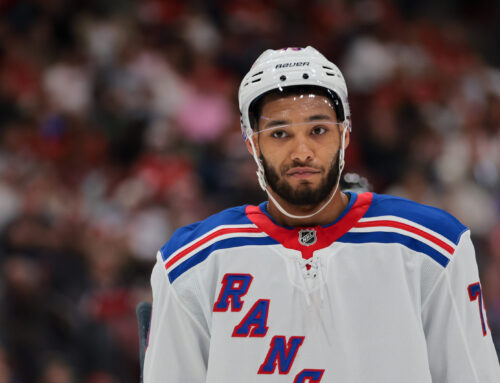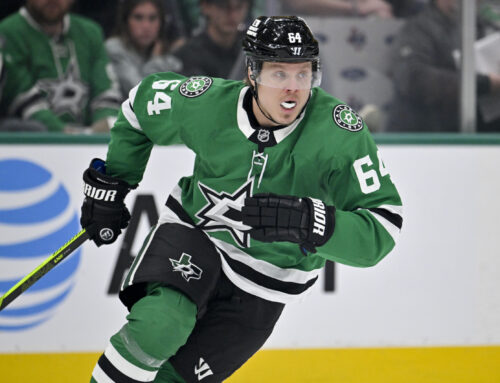One thing to keep in mind during your fantasy draft and then throughout the season is that you always want to target players who are getting plenty of power-play time.
After all, most leagues count power-play points as a category, but even in points-only pools, many players can get a boost by playing top minutes with the man advantage. A decent power play can mean the difference between a 60-point player and an 80-point player.
While there are fewer than two weeks to the season, I thought this would be a good time to start looking at players who were successful with the man advantage. Keep in mind that we’re not necessarily looking at the players who had the most power-play points. A player not expected to get any power-play points but nets 15 of them may be more of a surprise than a player expected to get 30 but winds up with 40.
10. Sam Reinhart
All this time, I thought Reinhart could never be a point-per-game player. After all, if he couldn’t do it alongside Jack Eichel in Buffalo, where could it happen? Well, it happened in Florida, but not alongside who you think. His most common five-on-five linemates are Mason Marchment, Anton Lundell, Carter Verhaeghe and Sam Bennett. Going into Sunday’s game, he only played 162 minutes alongside Jonathan Huberdeau and only 132 alongside Aleksander Barkov (and about 158 minutes with Eetu Luostarinen). Who knew he needed to be the main offensive player on an even-strength line instead of playing with elite linemates? However, it’s the opposite with the man advantage, as 26 of Reinhart’s 28 power-play points have come with Jonathan Huberdeau on the ice. Those 28 PPP are a huge improvement over last year’s 16 and only the second time he’s ever cracked 20 (he had 21 back in 2017-18).
9. J.T. Miller
Miller was one of the only Canucks to be consistently productive all year, but this should be nothing new for anyone following Miller the last few years. Miller has picked up a point in 53 games, tied for 10th best in the league, and 13 games better than the next best Canuck (Quinn Hughes). Last year, he had 31 games with a point (one behind Brock Boeser for the team lead), and the year before he had 46, four games higher than the next leading Canuck, Elias Pettersson. Miller’s 36 points are double the 18 he had a season ago. It’s not surprising that Miller is so good on the power play, but that he is third in the league with 36 man-advantage points. He has a chance of being one of only eight players in the last 10 years to net 40 power-play points in a season.
He doesn’t lead the Sabres in power-play points (that honor goes to Rasmus Dahlin), but credit should be given to the Sabres’ coaching staff. They gave Thompson power-play time right away (6:04 on the power play on opening night) and never faltered from it all season. The reward? A team-high 10 power-play goals and 16 power-play points. He’s been one of the top surprises of the year, and his power-play prowess is playing a big role in that success. As a bigger player, he may not reach his breakout threshold until his 400th game as he only has 218 right now.
A few years ago, Gostisbehere seemed to be a guaranteed 20 power-play points, even reaching 33 man-advantage points in 2017-18. Then the wheels fell off, and he dropped to below 10 in each of the last two seasons. A trade to Arizona didn’t look like a good sign considering the Coyotes are awful and already had Jacob Chychrun as their main power-play quarterback. However, Chychrun was lousy and/or injured, and Gostisbehere took over almost immediately. Ghost now has 17 power-play points and may reach 20 for the first time in years.
6. Sean Durzi
Durzi got on this list because of an opportunity, but he’s definitely been more successful than many could have hoped for. The 23-year-old rookie Kings defenseman has 13 power-play points, second among rookie defensemen and fourth among all rookies. That’s pretty impressive considering he spent the first part of the season dominating the AHL. Once Drew Doughty was sidelined with a wrist injury, Durzi has been getting the plum power-play minutes.
If there’s one lesson to be learned from this list, it’s that you should go all-in on players over 30 years of age to have career years thanks to hearty power-play production. That may be a slight exaggeration, but Zuccarello is one of several players listed to fall into this category. It took 12 seasons for Zuccarello to become a point-per-game player, and his power-play production is a big reason why. His 26 power-play points crush his six of last year and best his previous high of 18. I’d still be wary of him for next year as he doesn’t contribute in many other categories, but he could be a nice trade-high option this offseason if you own him in a keeper league.
Marchessault has to be one of the most underrated fantasy players. Since the Golden Knights played their first game, Marchessault finds himself in the top 40 in goals, top 45 in points, top 35 in plus-minus, and seventh in shots. Would you consider him a top-50 fantasy player? Of course not. Top 100? Still not enough for most of you, but he produces offense, will finish as a positive in the plus/minus category, is good for 3.2-shots per game and picks up a few PIM, all while missing very little time. You might have figured this would have been a letdown season for the Golden Knight, especially once Jack Eichel got in the lineup, but injuries to everyone else on the squad have continued to allow Marchessault to produce. His 20 power-play points are only two better than his career-high in 2016-17, is miles ahead of last year’s six power-play points, and is eight better than the next closest Golden Knight. That’s pretty good considering how underwhelming the Vegas power play has been.
3. Nazem Kadri
This was the season everything clicked for Kadri, and it’s a shame we didn’t get to see him finish the last month of the season. First, some context. He’s been used on the top power-play unit for the previous three years (one in Toronto, two in Colorado) but despite the usage, topped out at 13 power-play points in any of those seasons (and had 33 power-play points total over those three seasons). His previous career high was 18 power-play points. This year, he has 28 power-play points in 65 games and would have been a threat for 35 if he didn’t suffer an upper-body injury. There’s a chance he might reach 30 if he gets back into the lineup for a couple of games before the postseason, but there’s no word on if that will happen.
2. Matt Duchene
One of the dirty little secrets of the past dozen years is that Duchene has not been a proficient power-play producer. Many seem to believe that he is better than what he is, but that has a lot to do with his rookie season in 2009-10 when he notched 21 power-play points. He hasn’t had 20 since and only reached 15 man-advantage points three other times, the last back in 2015-16. Last season was awful, with three power-play points in 34 games. You probably would have been ecstatic with 15 this year. He is now sitting at 25 power-play points, 15 of which have been goals. For comparison, he had 12 power-play goals in his previous three seasons combined.
I’m not sure if we’ve ever seen a breakthrough season like this from a player in his 30s. While many are focusing on the fact he now has 50 goals on the season (an amazing accomplishment), his power-play goal prowess is equally astounding. Last year, he set a career high with 11 power-play goals and 14 power-play points. This year, he crushed that with 25 power-play goals and 33 power-play points. The power-play goals lead the league and the power-play points are tied for seventh. Alex Ovechkin is the only other player to have 25 power-play goals in any season of the past 15 years, and Ilya Kovalchuk is the only player in the past 25 years to have more than 25 power-play goals (he had 27 in 2005-06). With a couple more goals, Kreider could find himself in rarefied company.





 ANA
ANA PHI
PHI VAN
VAN DET
DET BUF
BUF NYR
NYR MIN
MIN WSH
WSH
